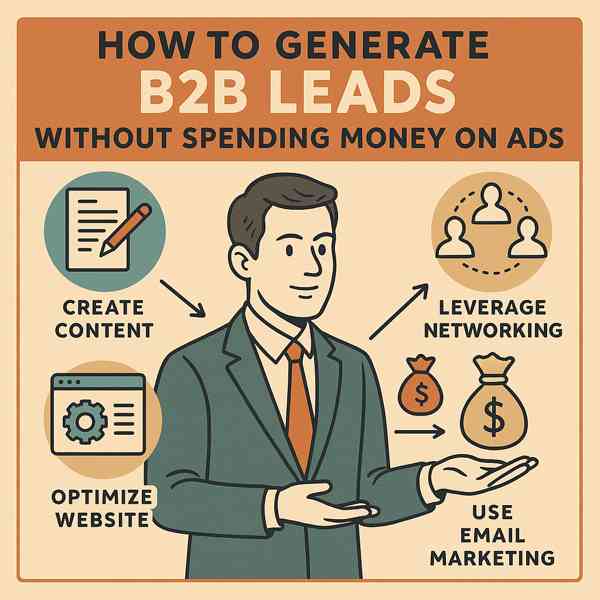The Role of Email Sequences in B2B Lead Nurturing
Email sequences play a vital role in B2B lead nurturing. They help businesses connect with potential customers over time. This process builds relationships and trust. It is not just about selling. Instead, it focuses on understanding the needs of leads. By using email sequences, companies can guide leads toward making informed decisions. This article will explore how email sequences work and why they are important for businesses.

What Are Email Sequences in B2B Marketing?
![]()
Email sequences are groups of emails sent to leads. They follow a specific plan or schedule. Each email has a purpose. The goal is to nurture leads until they are ready to buy. Here are some key points:
- Email sequences are automated.
- They can be tailored to different audiences.
- Each email builds on the previous one.
- They provide valuable information.
- Email sequences keep the audience engaged.
For example, a software company may send a sequence of five emails. The first email introduces the product. The second email shares customer testimonials. The third email provides a demo link. The fourth email discusses pricing. Finally, the fifth email includes a special offer. This structure helps keep the lead interested and informed.
Why Lead Nurturing Is Important in B2B
![]()
Lead nurturing is essential in B2B marketing. It helps businesses convert leads into customers. Here are some reasons why it matters:
- Most leads do not buy immediately.
- Building trust takes time.
- Nurturing leads improves conversion rates.
- It helps businesses stand out from competitors.
- Effective nurturing reduces buyer’s remorse.
According to research, nurtured leads make 47% larger purchases than non-nurtured leads. This shows that nurturing is not just helpful; it is also profitable. Companies that invest in lead nurturing often see better results.
How Email Sequences Enhance Lead Nurturing
![]()
Email sequences enhance lead nurturing in several ways. They create a structured approach to communication. Here are some benefits:
- Consistency: Emails go out at regular intervals.
- Personalization: Emails can be tailored to individual needs.
- Automation: Saves time for marketers.
- Tracking: Companies can measure engagement levels.
- Feedback: Businesses can adjust based on responses.
For instance, a marketing agency may use email sequences to follow up with leads. They might track open rates and click-through rates. If many leads open the first email but not the second, they can revise the second email. This feedback loop helps improve future campaigns.
Steps to Create Effective Email Sequences
![]()
Creating effective email sequences requires careful planning. Here are steps to consider:
- Define your goals: What do you want to achieve?
- Know your audience: Understand their needs and preferences.
- Plan the content: Decide what each email will say.
- Set the timing: Determine how often to send emails.
- Test and refine: Monitor performance and make adjustments.
For example, a company might set a goal to increase demo requests. They could create a sequence of three emails. The first email would introduce the service. The second would share a case study. The third would include a call-to-action for a demo. Testing different timings can help find the best schedule.
Common Mistakes in Email Sequences
![]()
Even experienced marketers can make mistakes with email sequences. Here are some common errors to avoid:
- Sending too many emails: This can annoy leads.
- Being too pushy: Focus on providing value, not just selling.
- Lack of personalization: Generic emails don’t engage.
- Not tracking results: Failing to analyze performance limits improvement.
- Ignoring feedback: Listening to leads is crucial.
A study found that 74% of consumers feel frustrated when website content is not personalized. This statistic highlights the importance of tailoring emails. Companies should aim to create relevant and engaging content to avoid losing leads.
Case Studies of Successful Email Sequences
![]()
Many companies have successfully used email sequences for lead nurturing. Here are two examples:
- Company A: A tech startup increased its demo requests by 300% after implementing a targeted email sequence. They focused on educating leads about their product.
- Company B: An online retailer improved its sales conversion rate by 50% through personalized follow-up emails. They used data from previous interactions to tailor their messages.
These examples show how effective email sequences can be. By focusing on the needs of leads, companies can drive better results.
Measuring the Success of Email Sequences
![]()
Measuring success is crucial for improving email sequences. Here are some metrics to track:
- Open rates: How many people opened the email?
- Click-through rates: How many clicked on links inside the email?
- Conversion rates: How many took the desired action?
- Unsubscribe rates: How many opted out of the email list?
- Response rates: How many replies did you receive?
By analyzing these metrics, companies can gain insights. For example, if open rates are low, they may need to improve subject lines. If click-through rates are high but conversions are low, the landing page might need tweaking.
Conclusion: The Importance of Email Sequences in B2B
![]()
In summary, email sequences are a powerful tool in B2B lead nurturing. They help build relationships and guide potential customers. By creating effective email sequences, businesses can improve their chances of converting leads. Avoiding common mistakes and measuring success are also important. Overall, investing time in email sequences can lead to significant rewards for any business.




